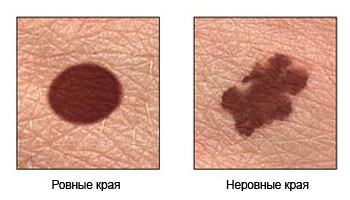Melanoma
Description melanoma
Cm. also Tumors of the chromogenic tissue
Melanoma – skin cancer. Melanoma affects the skin cells, called melanocytes. These cells are responsible for the color of the skin. They also give the birthmarks their dark color. Under normal conditions, moles are benign tumors of the skin. Sometimes a mole can turn into melanoma. A new mole may also be melanoma at an early stage.
Melanoma is uncommon, but quite dangerous, as easily it can spread to other parts of the body.

Causes Melanoma
Skin cancer can cause:
- Ultraviolet radiation from the sun;
- Artificial radiation of ultraviolet lamps and frequent visits to the solarium.
Risk factors for melanoma
Factors, which increases the risk of melanoma:
- Some kinds of birthmarks, called dysplastic nevi or atypical moles (resemble melanoma);
- Large dysplastic nevi, existing at birth;
- Age: Early adulthood, advanced age;
- Race: white;
- Red or blond hair;
- Light eyes;
- The presence of family members with melanoma;
- Excessive exposure to the sun, sun exposure without protective clothing or sunscreen;
- Suppression of the immune system.
Symptoms of melanoma
Melanoma is usually not painful. Also, it often has no symptoms. The first sign is usually a resizing, shape, color or sensitivity of existing moles. Also melanosomes may appear as new, dark, discolored, or abnormal mole. Remember, that most people have moles. Almost all moles are benign.
Signs, a mole that may be melanoma:
- Uneven shape – It does not correspond to one half on the other half of the form;
- Ragged – torn, toothed, blurred or irregular; pigment may spread to the surrounding skin;
- Uneven color – uneven color, with shades of black, brown, or tan, and, perhaps, even white, Grey, pink, red or blue;
- Resize – usually, birthmark increases, and become deeper than 5 diameter greater 15 millimeters;
- Changes in texture – It may start with small changes in the skin and become a tumor in advanced cases;
- Bleeding – the skin may begin to itch, or bleed in more advanced cases.

Diagnosis of melanoma
The doctor will ask about your symptoms and medical history, and perform a physical examination. He will examine your skin and moles. It will also take a biopsy of the skin. Other moles will be monitored over time.
The doctor may also examine lymph nodes, which are located in the groin, armpits, neck, or in areas near the suspicious mole. Swollen lymph nodes may indicate the spread of melanoma. The doctor may need to remove a sample of lymph node tissue to test for cancer cells.
Treatment melonomy
After finding melonomy survey is conducted, allowing to determine the extent and scope of cancer. The method of treatment depends on the degree of spread of cancer.
Surgery to remove the melanoma
Melanoma and some of the healthy tissue around it are removed. If a large area of tissue is removed, It can be made by skin grafting. Lymph nodes near the tumor can also be removed.
Chemotherapy melanome
Chemotherapy – the use of drugs to kill cancer cells. Preparations for the chemotherapy may be given in various forms: tablets, injection, the introduction of a catheter.
Biological therapy for melanoma
Biological therapy involves substances, produced by the body, that allows you to increase or restore the natural defenses against cancer. Examples of drugs:
- Interferon;
- Interleukin-2;
- Vaccines against melanoma;
Radiation therapy for melanoma
Radiation therapy – Use of radiation, to kill cancer cells and shrink tumors. Radiation therapy is not completely cure from melanoma. It is used in combination with other therapies.
Preventing melanoma
To reduce the likelihood of melanoma:
- Avoid spending too much time in the sun;
- Protect your skin from the sun. For Example, wear shirt, a hat with wide margins and sunglasses;
- Use a sunscreen with a sun protection factor (SPF) no less 15;
- Do not expose your skin to the sun:
- FROM 10:00 morning 15:00 evening (standard time);
- FROM 11:00 morning 15:00 evening (summer time);
- It is necessary to avoid exposure to UV light and frequent visits to the solarium.
To detect an early stage melanoma:
- Consult your doctor, If you think, you have melanoma;
- If you have many moles or a family history of melanoma, you need to regularly check your skin for changes in the appearance of new moles;
- Ask your doctor how to perform self-examination of the skin. This will find new or changing moles.
